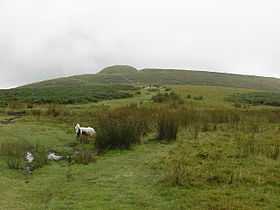Twmbarlwm
| Twmbarlwm | |
|---|---|
 Twmbarlwm | |
| Elevation | 419 m (1,375 ft) |
| Prominence | 47 m (154 ft) |
| Location | |
 Twmbarlwm | |
| OS grid | ST242926 |
| Coordinates | 51°37′38″N 3°05′47″W / 51.62722°N 3.09639°WCoordinates: 51°37′38″N 3°05′47″W / 51.62722°N 3.09639°W |
| Topo map | OS Landranger 171 |
Twmbarlwm also known as Twm Barlwm, Twyn Barlwm, or locally known as "The twmp" (translation: hump)or the Pimple because of the mound that lies at its summit, is a mountain situated 2 km (1.2 mi) to the northeast of Risca in South Wales. It is 419 m (1,375 ft) high and is a well known landmark throughout the region. It commands extensive views across what is now the M4 corridor, over Newport and Cwmbran and out over the Bristol Channel .
History
At the top of the mountain, near its summit, are the remains of what is presumed to be an Iron Age hill fort, believed to have been built by the Silures, the Celtic tribe that inhabited the area before and during Roman times. These remains have led the local people of Risca and Cwmcarn to call it "The tump". There was also thereafter possibly a Roman signal point and a substantial Norman motte and bailey castle which is incorporated into the eastern end of the fort, probably of early Norman construction.
In popular culture
The mountain itself is a well known local landmark visible on the skyline for many miles and is indeed seen as a symbol of Monmouthshire/Gwent. It is very popular for hillwalking and mountain biking and with tourists who visit Cwmcarn Forest Drive or walk the Gwent Ridgeway. It features heavily in local folk legends with tales of a giant buried here, and treasure, supposedly guarded by swarms of bees. Local legend says that the druids regarded it as a sacred site and a place of judgement.
The hill fort is known to locals as 'the pimple' or 'the nipple'. An example of the use of the term came during a boxing commentary on national radio by the BBC's Raymond Glendenning, who had grown up in Newport. As one of the boxers rose after being floored, Glendenning excitedly announced to the listeners that 'he has a lump on his head the size of the pimple on the top of Twm Barlwm!' Of course this was completely incomprehensible to all but those from Risca or Newport.
Youngsters from neighbouring areas and council estates such as that at Bettws often walk to the top of Twmbarlwm and back home on Good Friday, as a sort of tradition amongst friends and youngsters in the community.
The mountain also is noted in the work of such local writers as W H Davies and Arthur Machen. Machen described it in his autobiography Far Off Things (1922): "As soon as I saw anything I saw Twym Barlwm, that mystic tumulus, the memorial of peoples that dwelt in that region before the Celts left the Land of Summer." This description was 'borrowed' by Dylan Thomas for Llareggub Hill in his Under Milk Wood.[1] Local historian and folklorist Fred Hando tells of the "Mountain Organ" produced by the wind on the southern slopes of the hill, and of the nearby "Pool of Avarice" the site of a great house which was swallowed wholesale by a landslip after the mistress of the house had turned away a hungy beggar.[2] The Cistercian Way passes through Llantarnam, Old Cwmbrân, Greenmeadow and Thornhill before reaching the ancient chapel of Llanderfel on Mynydd Maen, and then onwards to Twmbarlwm.
In the past 20 years extensive damage has occurred to both the tump and surrounding areas, caused primarily by illegal off-road motorcycles. Several attempts have been made by the local councils to limit this damage by fencing off large areas, but so far all have failed with the fences being destroyed within weeks of erection.
Twmbarlwm Gallery
-
Twmbarlwm seen from Llanfrechfa
-
View from Twmbarlwm over Cwmbran
-
View from Twmbarlwm looking out over the Bristol Channel towards England


